#marine shipping companies in india
Explore tagged Tumblr posts
Text
What technical services does Nautilus Shipping offer?
As a leading ship management company in India, Nautilus Shipping offers a comprehensive array of technical services aimed at optimising vessel performance, ensuring regulatory compliance, and enhancing safety at sea.
One of the primary technical services provided by Nautilus Shipping is full technical management of vessels. Leveraging our extensive expertise and network of qualified technicians, we provide technical services including technical inspections for owners, banks, insurers and bareboat charterers, superintendence for emergency or scheduled repairs and dry-docking, hiring surveys, ship specific computerised planned maintenance system, periodic analysis of fuel and lubricants, regular maintenance checks, monitoring of peak performance metrics and implementation preventative maintenance strategies to minimise downtime and ensure operational readiness.

Additionally, Nautilus Shipping is highly committed to vessel and crew safety at every step and offers onboard safety and security training of staff as well as emergency incident management. We also offer technical consultancy services, providing expert advice on optimising vessel performance, enhancing fuel efficiency, and complying with industry regulations.
Nautilus Shipping also provides comprehensive dry-docking services, managing the entire process from planning and preparation to execution and post-docking inspections. Committed to safety and excellence, Nautilus Shipping offers a wide range of technical services tailored to the unique needs of vessel owners and operators. With our expertise and focus on innovation, we strive to be a trusted partner in optimising vessel performance and ensuring the safety and compliance of maritime operations.
#ship management company#shipping management companies#marine ship management#marine shipping companies in india
0 notes
Text
Nautilus Shipping: Premier Ship Management Services in India
Nautilus Shipping stands out among marine shipping companies in India, offering top-tier commercial management and ship broking services. Our expertise covers strategic negotiation and management of charter party contracts, with comprehensive post-fixture support and diligent account tracking. We assist in developing chartering strategies, finding the best employment opportunities for vessels, and ensuring compliance with charter party terms through detailed vessel monitoring and coordination with port agents. Our services extend to managing demurrage and dispatch calculations, conducting thorough voyage reporting and analysis, and facilitating the supply and financial management of marine fuels. With Nautilus Shipping, navigate your shipping operations with confidence and efficiency. Visit us at:
#marine shipping companies in india#ship management services India#ship crew management companies#procurement crewing services#crew management services#ship management companies#shipping#marineshipping#marine life#shipping container
0 notes
Text
I mean, there is at least one ship of this style still active. The Götheborg of Sweden is a replica 1700s sailing ship that even rescued a boat that broke a rudder in April 26, 2023.
Pretty much all the articles use the same photo from the small ship of the huge wooden boat, it's amusing.
There's plenty of news stories about it's tours. So wish granted! Here's the exact ship you want to see!
...Also kinda amusing this all happened literally 3 days after OP's post.
We need to go back to using sailing ships full time like immediately. Yes it would take longer to get places but the Aesthetic is unmatched
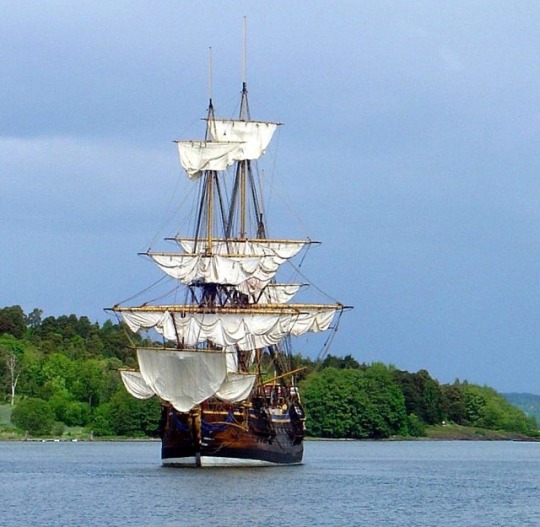
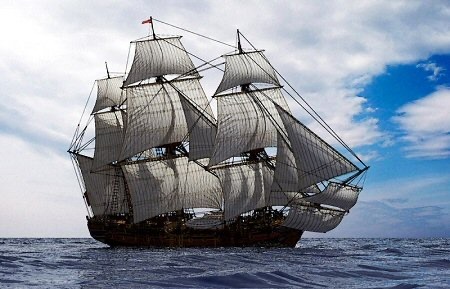
Like there is nothing sexier hthan this
#gotheborg of sweden#18th century ship#1700s ship#wooden sailing ship#east india company sailing ship#world's largest ocean-going wooden sailing ship#gotheborg#marine news#replica ship
283K notes
·
View notes
Text
Cargo Gear Testing Services – Reliable Marine Solutions by Gujmar.com
Gujmar.com offers professional cargo gear testing as part of our comprehensive marine services. As a top ship supplier and ship chandler in India, we ensure quality and safety across ship provisions, repairs, and marine fuel supply. Trust the best ship supply company in India for reliable service.
#Ship Supplier#Ship Chandler#Marine Services#Marine Paints#Ship Provisions#Ship Repair#Top Ship Chandlers In India#Ship Stores Suppliers In India#Marine Fuel Suppliers In India#Best Ship Supply Company In India
0 notes
Text
What is commercial inland marine insurance ?
Commercial Inland Marine Insurance is a comprehensive policy.Provides 24/7, 365-day coverage.Safeguards businesses involved in importing, exporting, or transporting goods within India.Covers goods in transit via various modes, including road, rail, and air.Protects against potential damage, loss, accidents, and perils during operations Key Benefits in a Nutshell
Extensive coverage for various risks. Damage due to accidents, theft, natural disasters, and fire incidents included. General expenses like contributions to general average, salvage costs, and sue and labour expenses covered. Protection against liabilities arising from collisions, contact with other vessels, or property damage. Coverage for delays in transit, quarantine compensation, temperature-controlled cargo, and mor
#marine insurance policy coverage#marine insurance for car shipping#marine insurance for cargo#marine insurance in uttar Pradesh#marine insurance in rajasthan#marine insurance for container#marine insurance companies in india#marine insurance for trucks#marine insurance in transit#marine insurance open policy#marine insurance contract#marine insurance company jobs#inland marine insurance for jewelry#assignment of marine insurance policy#marine hull and machinery insurance policy wording#annual policy in marine insurance#what is an inland marine insurance policy#what does a marine insurance policy cover#bajaj allianz marine insurance policy wording#tata aig marine insurance policy#tata aig marine insurance policy wording#what is a marine insurance policy#what does an inland marine insurance policy cover#controlled lines inland marine insurance policy form#conditions of marine insurance policy#clauses of marine insurance policy#classification of marine insurance policy#marine insurance policy wording#cargo marine insurance policy#classes of marine insurance policy in india
1 note
·
View note
Text
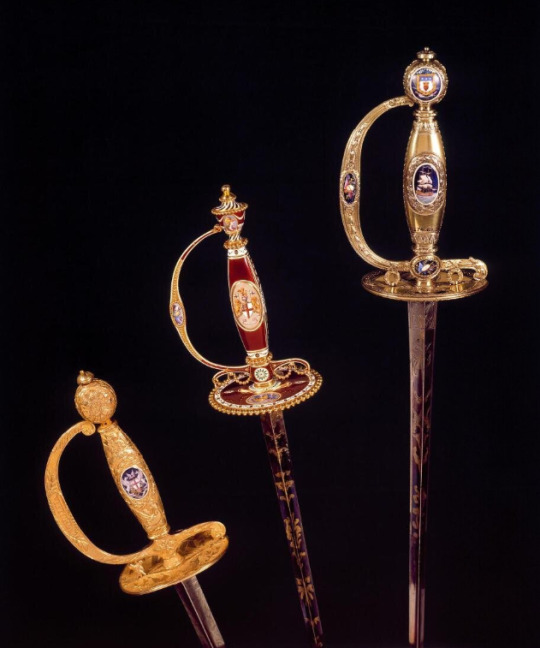
Presentation small swords, 18th century - early 19th century
Presentation small sword presented to Lt. General Sir Rowland Hill in recognition of his services under Wellington at the Battle of Vittoria on 21st June, 1813. Made by John Ray and James Montague, London.
Presentation small sword by James Morisset of London. Inscribed 'Presented to Lt. Colonel James Hartley in testimony of his brave & gallant conduct by the Honble East India Company 1779'.
Presentation small sword, by James Morisset of London. ‘Presented by the Committee of Merchants & of London to LIEUT.T FRANCIS DOUGLAS for his Spirited and active conduct on board His Majesty’s Ship the REPULSE. Ja.s Alms Esq.r Commander during the MUTINY at the NORE in 1797. Marine Society Office, May 1o 1798 } Hugh Inglis Esq.r Chairman’.
#naval weapons#army weapons#small swords#presentation swords#18th century - early 19th century#age of sail#napoleonic wars
106 notes
·
View notes
Text
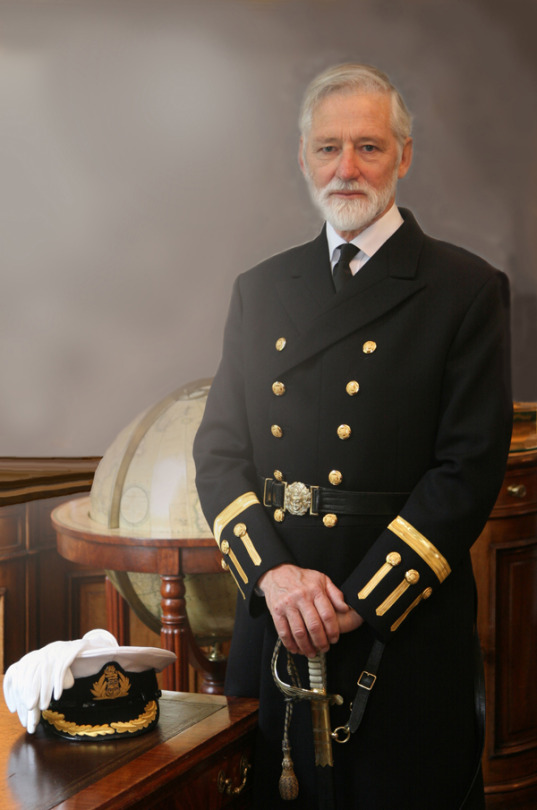
Richard Woodman
Writer who drew on his own experience at sea in a series of novels and historical works about the British merchant navy
“The end was anticlimax. We slipped home unnoticed. Britain turned no hair at our arrival, as just as she has turned no hair at our extinction.” When Richard Woodman published Voyage East in 1988, he knew that the mercantile world depicted within it, which he had joined aged 16, was gone.
The first-person novel – which never reads like fiction – describes the voyage of a cargo liner carrying goods and passengers from Liverpool to Singapore, Hong Kong, Kobe and Shanghai in the mid-1960s. There is a moment, off the coast of Borneo, when the captain sees a vessel with half a dozen grey aluminium boxes on her foredeck: “What the devil are they?” he asks the pilot. “‘They’re containers, Captain,’ the Pilot replied, and no one on the bridge heard the sentence of death pronounced upon us.”
Woodman, who has died aged 80, became the memorialist of the merchant fleets. Between 2008 and 2016 he wrote the history of the British merchant navy in five volumes, followed by A Low Set of Blackguards, a two-volume history (2016-17) of the East India Company.
His outstanding contribution came through his three second world war convoy histories: Arctic Convoys (1994), Malta Convoys (2000) and The Real Cruel Sea (2005). These are works of passion, based on experience and scrupulous research.
The loss of life among merchant seamen was proportionately greater than in any of the armed services and the recognition they received far less. From the beginning of the war a seafarer’s pay was stopped the minute his ship was sunk. “Time spent fighting for his life on a float or lifeboat was an unpaid excursion,” wrote Woodman.
While Winston Churchill acknowledged the crucial importance of the Battle of the Atlantic to national survival, it was not until 2012 that those who had served in the Arctic convoys, and had taken the highest casualties of all, were retrospectively honoured.
Born in north London, Richard was the elder son of Rosalie (nee Cann) and Douglas Woodman, a civil service administrator. Though he was far from the sea, his imagination was captured by the works of Arthur Ransome, Daniel Defoe, RM Ballantyne and Alan Villiers, and his enthusiasm nurtured by Sea Scout membership.
He was the youngest member of the Sea Scout crew that sailed the ex-German yawl Nordwind in the 1960 Tall Ships race and, despite failing all but two of his O-levels, he was accepted as an indentured apprentice with the Alfred Holt (Blue Funnel) line in 1960.
His first long trip to Australia came as a midshipman on the SS Glenarty, returning via the US: “I had been round the world before I would have been allowed inside a British pub.” Life on board ship took place in an uncompromising, all-male environment: the almost compulsory swearing, drinking and sexist banter encouraged the development of “a carapace behind which we hid our private selves”.
Woodman responded eagerly to the hands-on education in seamanship and navigation, developed his writing and sketching through the log-keeping and read his way through the excellent ships’ libraries provided by the Marine Society. He completed his four-year apprenticeship and gained his second mate’s certificate. He was, however, in love and hated saying goodbye to his girlfriend, Christine Hite, an art student, for many months at a time.
He left Blue Funnel in the mid-1960s and went to work for the Ocean Weather Service, where he discovered how vicious the North Atlantic winter weather systems could be – and how pitilessly an ex-second world war corvette would roll. Fortunately it was not long before a temporary position became available with Trinity House, the corporation charged with the maintenance of navigation marks around England, Wales and the Channel Islands.
The position became permanent; he and Christine married in 1969 and settled in Harwich, Essex, near the Trinity House east coast depot, and he served the corporation for most of the rest of his life.
The work at sea was varied, challenging, sometimes dangerous. Precise navigation, seamanship and attention to detail were essential qualities, but Woodman also found time to write. His first novel, The Eye of the Fleet, was published in 1981. This introduced a series of 14 adventures featuring the young Nathaniel Drinkwater, a hero somewhat in the Horatio Hornblower mode but bearing the unmistakable stamp of a writer who was also a sailor.
Despite his professional career being in motorised vessels, Woodman loved traditional gaff-rigged yachts, particularly his own Kestrel and then Andromeda, in which he and Christine explored the east coast rivers and beyond. The action of his nautical novels often turns on neat, seamanlike manoeuvres as well as including varied and closely observed seascapes.
His productivity was astonishing. He often wrote two or three novels a year and soon added non-fiction to his output. When he became captain of Trinity House Vessel Patricia, he achieved this by having two desks, one from which he could conduct official business, the other hidden behind a door, with a page from the work in progress always ready in the typewriter.
Meanwhile, in his job he was extremely focused, conscientious and painstaking. Although some remember him as being of the “old school”, Jill Kernick, the first woman in almost 500 years to work at sea for Trinity House, credits him with helping her break through traditional barriers in the early 80s.
In 1997 Woodman retired to write full time, but was soon elected a Younger Brother of Trinity House, and then an Elder Brother, the first time a former employee was accorded this honour. He was diagnosed with cancer in 2003 but there was no let-up in his work rate. His last completed novel, A River in Borneo (2022), harks back to 60s Indonesia but sets its final scene in a Colchester hospice.
He is survived by Christine and their children, Abigail and Edward, and grandson, Arlo.
🔔 Richard Martin Woodman, master mariner and author, born 10 March 1944; died 2 October 2024
Daily inspiration. Discover more photos at Just for Books…?
26 notes
·
View notes
Text

Chinese Porcelains Recovered From Centuries-Old Shipwreck Head to Auction
The porcelain vessels spent over 300 years at the bottom of the South China Sea.
Trawling the seabed near the south coast of Vietnam in 1989, a Vietnamese fisherman stumbled upon the remains of the wreck of a ship that was traveling from China to Jakarta when it sunk some three centuries before. Among the haul, which included everyday items like bamboo combs, tweezers, and dice, were a whopping 48,288 pieces of Qing dynasty porcelain. In Jakarta, traders of the globe-spanning Dutch East India Company had planned to transport the vessels to Holland. Some 28,000 were sold at a 1992 Christie’s auction in Amsterdam, their likely planned destination, for a total of $7.3 million.
Now, on October 10, a group of 20 of these vases, with all their historic resonance, is being offered in an online auction at Stair Galleries, in Hudson, New York, which handles traditional furniture and fine art. Ranging between five to eight inches-high and displaying intricate floral patterns typical of traditional Chinese pottery, the group bears a very modest high estimate of $1,200.

The “Vung Tau Cargo,” so called for the Vietnamese coastal city of Vũng Tàu, near which it was discovered, has had a notable history since it was raised from its watery grave by the state-owned Vietnam Salvage Corporation in a joint venture with none other than the famed Swedish treasure hunter Sverker Hallstrom.
As for the porcelain booty that wasn’t auctioned off at Christie’s Amsterdam in 1992, some went to Hallstrom’s personal collection, other pieces to the Vietnamese government. Others still fell into the hands of Alberto Pinto, a Parisian photographer and interior designer of Jewish-Moroccan origin, who acquired them at Sotheby’s in 1999. Pinto would then sell the 20 vessels now being offered at Stair at another Christie’s auction in 2006.
“Wear consistent with age and use,” the company’s online listing notes of the condition of the pieces, dryly enough in view of their history. It notes that five of the beakers have chipped rims, repairs or hairline cracks. Four of the vases and covers have some chips in the rims or feet, a few of them large. “Otherwise in good condition,” said the house.
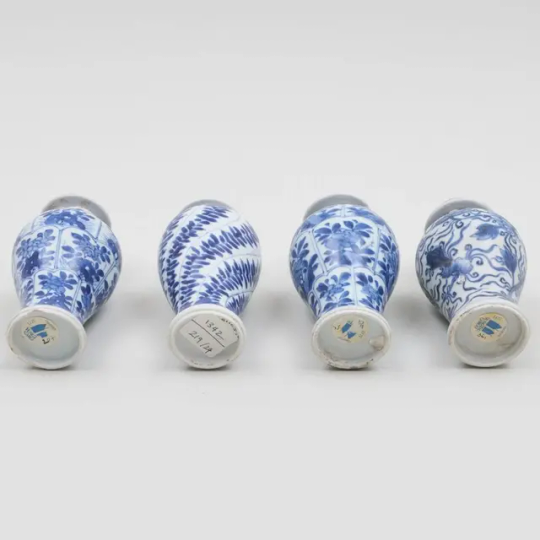
“Some trademarks of ‘cargo porcelain’ have a somewhat cloudy appearance and in some cases encrustations of marine life,” said Lauren Anderson, director of exposition sales at Stair, adding that the cargo was “very fashionable with interior designers” like Pinto. Throughout his life but especially after becoming wealthy and successful, Pinto was known as a passionate collector of antique tableware, acquiring cutlery, porcelain, and linen from both Europe and Asia. (His collection also includes furniture, statues, and a sizable survey of Impressionist paintings, including Édouard Vuillard’s 1921 Lucien Guitry.)
By Tim Brinkhof.
#Chinese Porcelains Recovered From Centuries-Old Shipwreck Head to Auction#Vung Tau Cargo#Vũng Tàu#cargo porcelain#porcelain#shipwreck#ancient artifacts#archeology#archeolgst#history#history news#art#ancient art#art history#antiques#qing dynasty
22 notes
·
View notes
Text

Italian company converts discarded fishing nets into chairs, car mats and Prada bags
Since 2009, Giulio Bonazzi, the son of a small textile producer in northern Italy, has been working on a solution: an efficient recycling process for nylon. As CEO and chairman of a company called Aquafil, Bonazzi is turning the fibers from fishing nets – and old carpets – into new threads for car mats, Adidas bikinis, environmentally friendly carpets and Prada bags.
For Bonazzi, shifting to recycled nylon was a question of survival for the family business. His parents founded a textile company in 1959 in a garage in Verona, Italy. Fifteen years later, they started Aquafil to produce nylon for making raincoats, an enterprise that led to factories on three continents. But before the turn of the century, cheap products from Asia flooded the market and destroyed Europe’s textile production. When Bonazzi had finished his business studies and prepared to take over the family company, he wondered how he could produce nylon, which is usually produced from petrochemicals, in a way that was both successful and ecologically sustainable.
The question led him on an intellectual journey as he read influential books by activists such as world-renowned marine biologist Sylvia Earle and got to know Michael Braungart, who helped develop the Cradle-to-Cradle ethos of a circular economy. But the challenges of applying these ideologies to his family business were steep. Although fishing nets have become a mainstay of environmental fashion ads—and giants like Dupont and BASF have made breakthroughs in recycling nylon—no one had been able to scale up these efforts.
For ten years, Bonazzi tinkered with ideas for a proprietary recycling process. “It’s incredibly difficult because these products are not made to be recycled,” Bonazzi says. One complication is the variety of materials used in older carpets. “They are made to be beautiful, to last, to be useful. We vastly underestimated the difficulty when we started.”
Soon it became clear to Bonazzi that he needed to change the entire production process. He found a way to disintegrate old fibers with heat and pull new strings from the discarded fishing nets and carpets. In 2022, his company Aquafil produced more than 45,000 tons of Econyl, which is 100% recycled nylon, from discarded waste.
More than half of Aquafil’s recyclate is from used goods. According to the company, the recycling saves 90 percent of the CO2 emissions compared to the production of conventional nylon. That amounts to saving 57,100 tons of CO2 equivalents for every 10,000 tons of Econyl produced.
Bonazzi collects fishing nets from all over the world, including Norway and Chile—which have the world’s largest salmon productions—in addition to the Mediterranean, Turkey, India, Japan, Thailand, the Philippines, Pakistan, and New Zealand. He counts the government leadership of Seychelles as his most recent client; the island has prohibited ships from throwing away their fishing nets, creating the demand for a reliable recycler. With nearly 3,000 employees, Aquafil operates almost 40 collection and production sites in a dozen countries, including four collection sites for old carpets in the U.S., located in California and Arizona.
#solarpunk#solarpunk business#solarpunk business models#solar punk#reculture#fishing nets#materials innovation#circular#waste#italy
25 notes
·
View notes
Text
"In the early morning hours of May 15, the cargo vessel Borkum stopped off the Spanish coast, lingering in the waters a short distance from Cartagena. At the port, protesters waved Palestinian flags and called on authorities to inspect the ship based on suspicions that it carried weapons bound for Israel.
Leftist members of the European Parliament sent a letter to Spanish President Pedro Sánchez requesting that the ship be prevented from docking. “Allowing a ship loaded with weapons destined for Israel is to allow the transit of arms to a country currently under investigation for genocide against the Palestinian people,” the group of nine MEPs warned.
Before the Spanish government could take a stand, the Borkum cancelled its planned stopover and continued to the Slovenian port of Koper. “We were right,” Inigo Errejon, the spokesperson for the hard-left Sumar party wrote on X, arguing that the Borkum’s decision to skip Cartagena confirmed the suspicions.
But missed in the debate over whether the ship ought to be allowed to dock in Spain were the unlikely origins of the Borkum’s cargo.
According to documents seen by Al Jazeera, the ship contained explosives loaded in India and was en route to Israel’s port of Ashdod, some 30km (18 miles) from the Gaza Strip. Marine tracking sites show it departed Chennai in southeast India on April 2 and circumnavigated Africa to avoid transiting through the Red Sea, where Yemen’s Houthis have been attacking vessels in reprisal for Israel’s war.
The identification codes specified in the documentation, obtained unofficially by the Solidarity Network Against the Palestinian Occupation (RESCOP), suggest the Borkum contained 20 tonnes of rocket engines, 12.5 tonnes of rockets with explosive charges, 1,500kg (3,300 pounds) of explosive substances and 740kg (1,630 pounds) of charges and propellants for cannons.
A paragraph on confidentiality specified that all employees, consultants or other relevant parties were mandated that “under no circumstances” were they to name IMI Systems or Israel. IMI Systems, a defence firm, was bought by Elbit Systems, Israel’s largest weapons manufacturer, in 2018."
#this article goes into great depth on how india has been manufacturing weapons for israel for a while now#and its quite likely that these weapons are being utilised by israhell to commit genocide against Palestine.#palestine#india#israel
17 notes
·
View notes
Text
Kanhoji Angre: the 18th-Century Maratha Admiral, Pseudo-Pirate, and All-Around Badass
So this post got more notes than I expected it to, so I figure I may as well follow through on my promise to make a post about him! You want to know about the aforementioned badass 18th-century Maratha navy admiral and pseudo-pirate who repeatedly fended off Western invasion in India? Then you shall. I wrote a paper about this guy, so here we go.

Let me introduce you to Kanhoji Angre. Information is scant on his early life and career—sources tend to disagree about his true origins and we don’t know a lot about his family status, but modern historians tend to trace his lineage to Tukoji Angre, his father, who distinguished himself in the early Maratha navy. We know Kanhoji was descended from a long line of Maratha mariners, which meant he fought in a number of naval raids and became acquainted with naval tactics as he grew up. As an adult, he began hiring out his own fleet to the Maratha navy itself, which, at the time, consisted only of numerous small ships and sought Angre’s heavier armament, which would become essentially the centerpiece of the naval force. In a sense he single-handedly built the Maratha navy into quite a formidable force, becoming Sarkhel, or admiral in 1698, and establishing numerous insurmountable forts along the coast.
Of course, the turn of the 18th century also coincided with growing European colonial intentions in India, and Angre’s presence is well-documented in East India Company records as a nuisance, a pirate, and a warlord in different capacities. To the English, he was a formidable pirate, a scourge to European ships on the west coast of the Indian subcontinent, and a menace to the Company, who suffered significant losses at his hand. Their interactions would eventually escalate into full-on military altercations, and the Company would go as far as to seek allyship with the Portuguese and the Viceroy of Goa, but Angre would remain undefeated throughout his lifetime, which consisted of many other interactions with various Western powers. He was arguably the most powerful maritime figure on the Indian coast by the time he died, but the European primary sources tend to play that down as far as they can for obvious reasons.
But I know you’re wondering—was he, then, a pirate? Well, it depends on who you ask. While Kanhoji Angre did, in certain ways, engage in actions that could be considered piracy from an English perspective, he still operated by a clear code of conduct. One account from 1716 tells of an interaction during which Angre detained an East India Company ship to determine whether they had a pass from the governor of Bombay, with whom he was bound to a nonaggression agreement, but otherwise did them no harm when he discovered they did. On the other hand, that same account quickly makes sure to mention how Angre would pursue vessels from Madras and Calcutta, the governments of which he had no agreements with. In the words of Patricia Risso in her excellent article about the topic, Angre “did not share the English legal definition of maritime violence,” which led to the inevitable branding of him as a pirate by the British, despite the fact that he did operate legally in accordance with those with whom he had such legal agreements. Whether this makes him a pirate or not is ultimately a matter of perspective, but in my humble opinion it certainly does not make him less cool.
Regardless of his status as a pirate or a military leader, Kanhoji Angre is a fascinating, highly overlooked, and pretty damn awesome figure in maritime history, and it’s a shame we don’t have more information on him. If you’re interested in more of the primary source material, I’d recommend checking out Clement Downing’s A Compendious History of the Indian Wars: With an Account of the Rise, Progress, Strength, and Forces of Angria the Pyrate, published in 1737 (free on Google Books!), for one such English perspective, which is the source I based my initial paper on. This is mostly my excuse to infodump about a guy I think history Tumblr would love, and who stands to be appreciated more for being an interesting dude and an all-around badass.
#i wrote 10 pages on this guy last semester I can do it again#the captain's lectures#age of sail#piracy#golden age of piracy#indian military#maratha military#maratha#naval history#colonialism#east india company#maritime history#this is your captain speaking#long post
27 notes
·
View notes
Text
How do oil tanker shipping companies in Mumbai navigate environmental challenges?
For oil tanker shipping companies in Mumbai, we provide comprehensive ship agency and logistics solutions. Our extensive partner network enables us to deliver port agency, marine, and logistics services seamlessly. From pre-arrival to post-departure, our operational team ensures precise and swift communication for efficient disbursement control. Leveraging our expertise, we prioritize quick vessel entry and exit from ports, managing all port services efficiently.

Recognizing the pivotal role of a qualified crew in ensuring safe and smooth vessel operations, we emphasize crew quality and efficiency. With crewing offices in Chennai, Goa, Mumbai, and Kochi, we maintain one of India's largest pools of skilled and dedicated seafarers.
Our crew supply services cater to various vessel types, employing modern search and selection techniques to recruit professionals with both the requisite qualifications and the right attitude for the job. From recruitment and training to management and deployment, we oversee all aspects of crew management, ensuring suitability for different vessels.
#oil tanker shipping companies in mumbai#bulk carrier shipping companies in india#ship management company#marine crew management services
1 note
·
View note
Text
The Flying Dutchman
The Flying Dutchman was a mythical ghostly ship cursed to sail the seven seas for eternity, never allowed to dock. While some say the ship herself is cursed, others say it’s the captain of the Dutchman that was cursed. Either way, the Flying Dutchman holds a long, twisting, and eerie story. While many people call it a fable told as a warning of the seas, sometimes by superstitious sailors, others have reported physically seeing the ship over the past few centuries. These reports span from the 1700s all the way to, surprisingly, World War II; most of these sightings are reported as occurring around Europe, or by Europeans/on European ships. For example, one sighting mentioned by Marine Insight was by a German submarine during WW2 while traveling east of Suez.
The Flying Dutchman is agreed to have originated from the Dutch East India Company’s ship fleet. As such, she would travel between the Netherlands and the East Indies, referring to modern southeast Asia. She was a merchant ship carrying goods like spices and silks, but unfortunately sank in a storm while sailing back to Amsterdam. But how did she become cursed? According to the folklore of the ship, her crew urged the Captain to turn back to safety when they saw the upcoming storm, but he ignored them and, in turn, urged them to continue sailing, even if it meant the ship would sail “until doomsday.” Some versions of the story claim this angered the gods, cursing the ship to quite literally sail forever; others point to the devil overhearing the Captain and cursing him to eternally sail. The same article by Marine Insight claims that the Captain could redeem himself from the devil by way of the love of a faithful woman. In this version, the Captain was allowed to make land once every seven years to find such a woman, and consequentially, salvation.
23 notes
·
View notes
Text
#unhallowedarts - The Flying Dutchman
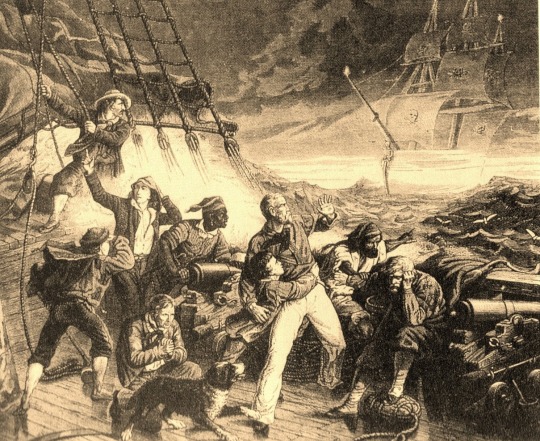
“You certainly know the fable of the Flying Dutchman. It is the story of an enchanted ship which can never arrive in port, and which since time immemorial has been sailing about at sea. When it meets a vessel, some of the unearthly sailors come in a boat and beg the others to take a packet of letters home for them. These letters must be nailed to the mast, else some misfortune will happen to the ship—above all if no Bible be on board, and no horse-shoe nailed to the foremast. The letters are always addressed to people whom no one knows, and who have long been dead, so that some late descendant gets a letter addressed to a far away great-great-grandmother, who has slept for centuries in her grave. That timber spectre, that grim grey ship, is so called from the captain, a Hollander, who once swore by all the devils that he would get round a certain mountain, whose name has escaped me, in spite of a fearful storm, though he should sail till the Day of Judgement. The devil took him at his word, therefore he must sail for ever, until set free by a woman's truth. The devil in his stupidity has no faith in female truth, and allowed the enchanted captain to land once in seven years and get married, and so find opportunities to save his soul. Poor Dutchman! He is often only too glad to be saved from his marriage and his wife-saviour, and get again on board.“ (Heinrich Heine)
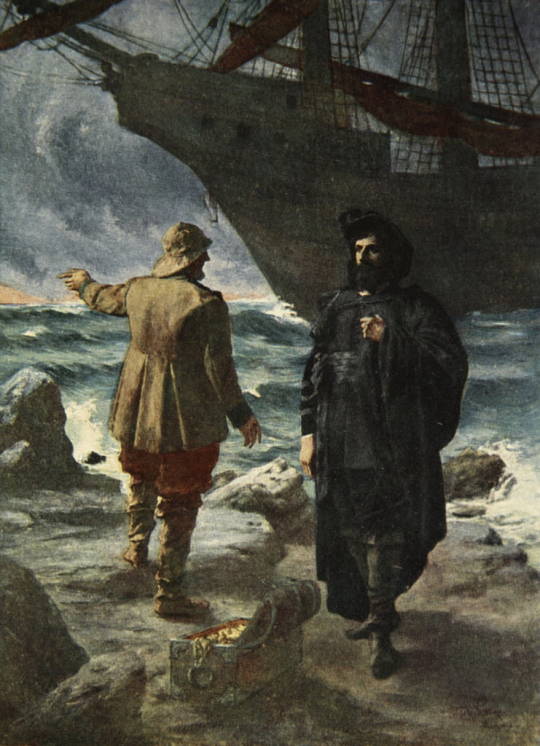
Ferdinand Leeke "The Flying Dutchman" (c 1905)
Naturally, Washington Irving naturalised him, quitting the Good Hope and sailing tof New Amsterdam to find redemption, the Flying Dutchman, Captain Vanderdecken, Tyn van Straten, van Diemen, van Evert, van Halen or Bernard Fokke of the VOC, the 17th century Dutch East India Company. Legend has it that he struck a with the devil to make the Java run in half the usual time. That he used iron yardarms, allowing him to have as much canvas aloft as possible, even when the feared Southeaster whipped the waters around the Cape that broke wooden spars on a regular basis – mere trivialities. He was, however, cursed to sail until Judgement Day, after he swore into the storm he would do exactly that until he rounded the Good Hope on his last voyage. The one he never returned from.
Ever since, his fluyt is seen in the Southern hemispheres, East of the Cape, with red sails flying in the sunset or bathed in a eerie red light, a portent of doom for those whose bows she crosses. Rich tales that not only inspired imaginative mariners, but professional storytellers as well, from Coleridge and Walter Scott to Hauff and Wagner and cohorts of 20th century journalists and pulp fiction writers. Ever since the 18th century. With the one from 1881 being the most prominent sighting, when HM frigate “Inconstant” encountered the Flying Dutchman with H future M George V on board, no less, who recorded in his log:
“July 11th. At 4 a.m. the Flying Dutchman crossed our bows. A strange red light as of a phantom ship all aglow, in the midst of which light the masts, spars and sails of a brig 200 yards distant stood out in strong relief as she came up on the port bow, where also the officer of the watch from the bridge clearly saw her, as did the quarterdeck midshipman, who was sent forward at once to the forecastle; but on arriving there was no vestige nor any sign whatever of any material ship was to be seen either near or right away to the horizon, the night being clear and the sea calm. Thirteen persons altogether saw her ... At 10.45 a.m. the ordinary seaman who had this morning reported the Flying Dutchman fell from the foretopmast crosstrees on to the topgallant forecastle and was smashed to atoms. “
There is, however, a later variant of the damned Dutch skipper’s tale, as told by Heine quoted above, the one that allows him to come ashore once every seven, ten or even hundred years, Brigadoon-like, and find a girl willing to love him, die with him and thus redeem the Flying Dutchman. Wagner famously elaborated on this version in the early 1840 after a rough but rather inspiring sea voyage, after reading Heine and being on the run from his creditors. Wagner made port in Norway twice. Where his Dutchman finds Senta who loves and dies for him and both finally ascend from the seas to heaven. Redemption. Since the last confirmed sighting of the “Flying Dutchman” was recorded in 1959 off Table Mountain, one must assume this is an operatic fable, though.
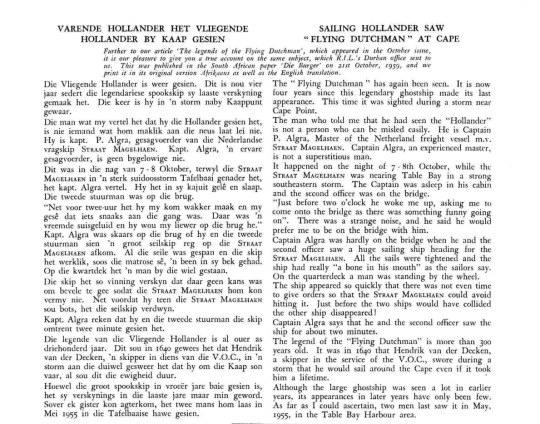
Contemporary Newspapers Clipping Reporting the Sighting of the "Flying Dutchman"
Heinrich Heine's Wagner- and yours-truly-inspiring aperçus from"The Memoirs of Herr von Schnabelewopski" can be read in full below:
#unhallowedarts#dark literature#dark aesthetic#dark art#ghost ship#folklore#dark folklore#flying dutchman#heinrich heine
17 notes
·
View notes
Text
Barge & Tug Services | Reliable Marine Support & Supplies in India - Gujmar.com
Explore Gujmar.com's barge and tug services, providing essential marine support across India's ports. As a top ship supplier and chandler, we offer marine fuel, ship provisions, repairs, and quality marine paints. Trust Gujmar.com for comprehensive marine services, making us one of the best ship supply companies in India.
#Ship Supplier#Ship Chandler#Marine Services#Marine Paints#Ship Provisions#Ship Repair#Top Ship Chandlers In India#Ship Stores Suppliers In India#Marine Fuel Suppliers In India#Best Ship Supply Company In India
0 notes
Text

Russia is developing a new advanced aircraft carrier project
Fernando Valduga By Fernando Valduga 01/18/2013 - 14:00 In Military
A concept of the Russian aircraft carrier called Project 23000.
Views
Share on Facebook
Share on Twitter
Russia's United Shipbuilding Corporation (USC) has a project for an advanced aircraft carrier in progress, while transmitting its own position to the command of the Russian Navy, USC CEO Alexey Rakhmanov said in an interview published on the corporation's website.
Meanwhile, the CEO pointed out that the corporation has its own opinion on "what is a future aircraft carrier, how it should be built and with what technological specifications.

The Tass news agency reported that Rakhmanov also confirmed that the heavy aircraft cruiser Admiral Kuznetsov will be commissioned in 2024. According to the CEO, this specific request involves more than 2,000 people.
"This is a question for the Navy - whether or not an aircraft carrier should be built and what kind of aircraft carrier. This discussion comes from the time I worked at the company for 8 years. We are proactive in design and regularly transmit our position to the Navy. We have to know, and know precisely, what our enemy thinks and what he does. The repairs did not stop even for a single minute of the cruiser's time on the pier," said Alexey Rakhmanov.

Admiral Kuznetsov is an aircraft carrier (cruiser of heavy aircraft in the Russian classification) serving as the flagship of the Russian Navy. It was built by the Black Sea Shipyard, the only manufacturer of Soviet aircraft carriers, in Nikolayev, in the then Soviet Socialist Republic of Ukraine (SSR) and launched in 1985, becoming fully operational in the Russian Navy in 1995. It was originally commissioned in the Soviet Marine Union, and was designed to be the leading ship of the Admiral Kuznetsov class of two ships. The second hull was eventually sold by Ukraine to China, modified in Dalian and commissioned as Liaoning.
In June 2021, Vladimir Korolev, vice president of United Shipbuilding Corporation, announced that the review and update of Admiral Kuznetsov should be completed by the first half of 2023.
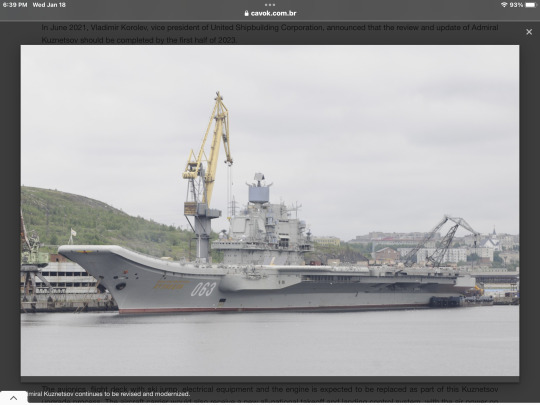
Admiral Kuznetsov continues to be revised and modernized.
The avionics, flight deck with ski jump, electrical equipment and the engine is expected to be replaced as part of this Kuznetsov upgrade process. The aircraft carrier would also receive a new all-national takeoff and landing control system, with the air power on board remaining the same.
Tags: Military Aviationaircraft carrierRussia
Sharing
tweet
Pin
Fernando Valduga
Fernando Valduga
Aviation photographer and pilot since 1992, he participated in several events and air operations, such as Cruzex, AirVenture, Dayton Airshow and FIDAE. He has works published in specialized aviation magazines in Brazil and abroad. He uses Canon equipment during his photographic work in the world of aviation.
Related news
INTERCEPTIONS
Aircraft loaded with drugs is intercepted by FAB Super Toucans in the interior of São Paulo
18/01/2023 - 18:29
MILITARY
IMAGES: Falcons join the Eagles and Raptors in Japan
18/01/2023 - 13:00
Helicopter carrying senior officials from Ukraine and children crashed near Kiev on January 18, 2022. (Photo: EPA / SERGEY DOLZHENKO) Dostawca: PAP/EPA.
AERONAUTICAL ACCIDENTS
Helicopter crash in Ukraine kills Ukrainian interior minister and children
18/01/2023 - 10:30
COMMERCIAL
Russia wants to leave partnership in the CRAIC CR929 program
18/01/2023 - 10:00
Saab Gripen E. Hunt. (Photo: Jamie Hunter)
SAAB
Saab cancels agreement with Adani to build fighters in India
18/01/2023 - 09:00
An S-70 Black Hawk from the Australian Army.
HELICOPTERS
Australia buys 40 UH-60M Black Hawk helicopters to replace its Taipans
18/01/2023 - 08:05
homeMain PageEditorialsINFORMATIONeventsCooperateSpecialitiesadvertiseabout
Cavok Brazil - Digital Tchê Web Creation
Commercial
Executive
Helicopters
HISTORY
Military
Brazilian Air Force
Space
Specialities
Cavok Brazil - Digital Tchê Web Creation
4 notes
·
View notes